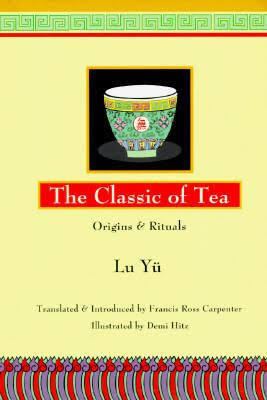8.4 /10 1 Votes8.4
Originally published October 2011 People also search for The Book of Tea | 4.2/5 Goodreads | |||||||||||||||||||||||||||||||||
 | ||||||||||||||||||||||||||||||||||
The Classic of Tea or Tea Classic (simplified Chinese: 茶经; traditional Chinese: 茶經; pinyin: chájīng) is the first known monograph on tea in the world, by Chinese writer Lu Yu between 760 CE and 762 CE, during the Tang Dynasty. Lu Yu's original work is lost; the earliest editions available date to the Ming Dynasty.
Contents
- Content of the Tea Classic
- One Origin
- Two Tools
- Three Making
- Four Utensils
- Five Boiling
- Six Drinking
- Seven History
- Eight Growing Regions
- Nine Simplify
- Ten Pictorialize
- References
According to tea lore, Lu Yu was an orphan of Jinling county (now Tianmen City in Hubei Province) who was adopted by a Buddhist monk of the Dragon Cloud Monastery. He refused to take up the monastic robes and was assigned menial jobs by his stepfather. Lu Yu ran away and joined the circus as a clown. At age 14, Lu Yu was discovered by the local governor Li Qiwu, who offered Lu Yu the use of his library and the opportunity to study with a teacher. During the An Lushan and Shi Siming rebellion period, Lu Yu retired to Shaoqi (now Wuxing county, Zhejiang). Lu Yu made friends with many literati, including the calligrapher Yan Zhenqing and the poet Huangfu Zheng.
For Lu Yu, tea symbolized the harmony and mysterious unity of the universe. "He invested the Ch'a Ching with the concept that dominated the religious thought of his age, whether Buddhist, Taoist, or Confucian: to see in the particular an expression of the universal".
In Lu Yu's hometown, Tianmen, there is an ancient styled tower named according to the classic in honour of the great writer.
Content of the Tea Classic
Lu Yu's Tea Classic is the earliest known treatise on tea, and perhaps the most famous work on tea. The book is not large, about 7000 Chinese characters in the literary language of the Tang Dynasty, a condensed, refined and poetic style of Chinese. It is made of "Three Scrolls Ten Chapters" (三卷十章):
One: Origin (一之源)
This chapter covers the mythological origins of tea in China. It also contains a horticultural description of the tea plant and its proper planting as well as some etymological speculation, features and characteristics of tea trees. The characteristics of quality tea leaves, and soils and topography compared to tea quality. Benefits of good teas and bad teas. The geographical region, harvest seasons and growing methods in relation to tea quality.
Two: Tools (二之具)
This chapter describes fifteen tools for picking, steaming, pressing, drying and storing tea leaves and cakes. Tools for making compressed tea brick, construction and recommended materials, specifications and instructions for these tools.
Three: Making (三之造)
This chapter recommends methods for the production of tea cake. The right time of the day, season and climate for plucking. Drying and storing of collected tea. Texture and features of quality brick tea. Understanding process methods and how to identify quality brick tea.
Four: Utensils (四之器)
This chapter describes twenty eight items used in the brewing and drinking of tea, including specifications and instructions, construction and recommended materials. The effect of these utensils to tea brew.
Five: Boiling (五之煮)
This chapter gives guidelines for the proper preparation of tea. Methods and steps for baking tea brick before brewing, storage of baked tea brick. Types of water and water quality, things to look out for and timing of boiling water. Steps and methods in preparing tea. The brewing methods are designed for tea of the Tang Dynasty.
Six: Drinking (六之飲)
This chapter discusses the actual consumption of tea, some of its properties, the history of tea drinking, and the various types of tea known in 8th century China. Reasons for drinking tea, how or when tea drinking started and its progress through the Tang Dynasty. Various types of tea and their drinking methods. Tea should be drunk pure without adding any ingredients to it, good tea brew should begin with careful preparation from cultivation to brewing. Methods of sharing tea with acquaintance.
Seven: History (七之事)
This chapter gives various anecdotes about the history of tea in Chinese records, from Shennong through the Tang Dynasty. Begin with an index list of influential individuals related to tea before the Tang Dynasty. A collection of literature and historical records on tea legends and famous people, folklore and customs, tea poems and tea stories, health benefits of tea in recorded medical books, tea as medical herb and tea cure formula, tea usage in cooking and tea recipes.
Eight: Growing Regions (八之出)
This chapter compares and ranks eight tea producing regions in China at its time.
Nine: Simplify (九之略)
This chapter lists procedures that may be omitted and under what circumstances. Tools and methods that can be excluded in cultivation and processing under abnormal conditions. Tea utensils and brewing methods that can be simplified or improvised under various outdoor and unusual habitat environments.
Ten: Pictorialize (十之圖)
This chapter consists of how to transfer the contents onto placards or large scrolls for hanging on the wall for quick references. The silk scrolls that provide an abbreviated version of the previous nine chapters.
